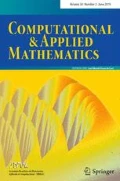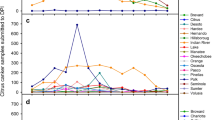Abstract
The largest citrus-producing region in Brazil, concentrated in the states of São Paulo and Minas Gerais, is also the largest citrus-producing region in the world. Data from 2016 indicate that for every five glasses of orange juice consumed in the world, three are produced in Brazil. Thus, citriculture stands out in Brazilian agribusiness. Along with the growth of this agricultural sector is the emergence of diseases that affect citrus trees. In this paper, two mathematical models are presented to describe the dynamics and chemical control of citrus diseases. These models involve the theory of optimal control, considering the spatial spread of disease vectors. The first model consists of a system of ordinary differential equations with transport rates. The second model involves the Greedy Randomized Adaptive Search Procedure in control theory, considering the spread of the vectors from a partial differential equation model involving diffusion. The models are approached in a scenario for Huanglongbing disease, also called greening, which is considered to be the most devastating citrus disease in the world because of its characteristics and the damage it causes, and because there is still no cure.









Similar content being viewed by others
Notes
The programming codes used for the simulations can be obtained from the link http://www.ime.unicamp.br/~biomat/Code-OptimalControl.pdf.
References
Bassanezi RB, Bassanezi RC (2008) An approach to model the impact of Huanglongbing on citrus yield. In: International Research Conference on Huanglongbing, Proceedings, vol 14, pp 301–304
Bové JM (2006) Huanglongbing: a destructive, newly-emerging, century-old disease of citrus. J Plant Pathol 88:7–37
FAO (2017) Citrus fruit—fresh and processed statistical bulletin 2016. Food and Agriculture Organization of the United Nations, Rome
Feo TA, Resende MGC (1995) Greedy randomized adaptive search procedures. J Glob Optim 6:109–134
FUNDECITRUS (2017a) Doenças e Pragas—HLB/Greening. http://www.fundecitrus.com.br/doencas/greening/10. Accessed Mar 2017
FUNDECITRUS (2017b) Levantamento de doenças dos citros: HLB, CVC e Cancro Cítrico no Cinturío Citrícola de São Paulo e Triângulo/Sudoeste Mineiro. Fundo de Defesa da Citricultura, Araraquara. http://www.fundecitrus.com.br/doencas/greening/10. Accessed Mar 2017
FUNDECITRUS (2017c) Reestimativa de safra de laranja 2016/17 do Cinturão Citrícola de São Paulo e Triângulo Mineiro/Sudoeste Mineiro - fechamento em abril/2017. Fundo de Defesa da Citricultura, Araraquara. http://www.fundecitrus.com.br/doencas/greening/10. Accessed Mar 2017
Gottwald TR, Graça JVD, Bassanezi RB (2007) Citrus huanglongbing: the pathogen and its impact. Plant Health Prog 8(1):31. https://doi.org/10.1094/PHP-2007-0906-01-RV
Grafton-Cardwell EE, Stelinski LL, Stansly PA (2013) Biology and management of Asian citrus psyllid, vector of the huanglongbing pathogen. Annu Rev Entomol 58:413–432
Lenhart S, Workman JT (2007) Optimal control applied to biological models. CRC Press, Boca Raton
Luiz MHR (2018) Dinâmica e controle de doenças de citros. Ph.thesis, IMECC-Unicamp
Pontryagin LS, Boltyanskij VG, Gamkrelidze RV, Mishchenko EF (1962) The mathematical theory of optimal processes. Interscience Publishers, New York
Resende MGC, Ribeiro CC (2010) Greedy randomized adaptive search procedures: advances, hybridizations, and applications. In: Gendreau M, Potvin JY (eds) Handbook of metaheuristics, vol 146. International series in operations research and management science. Springer, Boston, pp 283–319
Takahashi LT, Ferreira WC Jr, D’Afonseca LA (2001) Propagação da Dengue entre Cidades. Biomatemática 14:1–18
Author information
Authors and Affiliations
Corresponding author
Ethics declarations
Conflict of interest
The authors declare that they have no conflict of interest.
Additional information
Communicated by Luz de Teresa.
Publisher's Note
Springer Nature remains neutral with regard to jurisdictional claims in published maps and institutional affiliations.
L. T. Takahashi was partially supported by Coordenação de Aperfeiçoamento de Pessoal de Nível Superior-Brasil (CAPES)-Finance Code 001.
Rights and permissions
About this article
Cite this article
Luiz, M.H.R., Takahashi, L.T. & Bassanezi, R.C. Optimal control in citrus diseases. Comp. Appl. Math. 40, 191 (2021). https://doi.org/10.1007/s40314-021-01581-9
Received:
Revised:
Accepted:
Published:
DOI: https://doi.org/10.1007/s40314-021-01581-9




